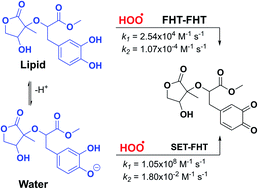The radical scavenging activity of muriolide in physiological environments: mechanistic and kinetic insights into double processes†
Abstract
Muriolide (MO) is a natural lactone that was isolated from Ranunculus muricatus. This compound exhibited good antioxidant activity in some experiments; however, the radical scavenging activity of MO in physiological environments has not been studied yet. In this study, the reaction between hydroperoxyl radical and MO was investigated in physiological environments by using density functional theory (DFT) calculations. It was found that MO exhibits excellent antiradical activity in water at physiological pH (k = 1.05 × 108 M−1 s−1) by the single electron transfer mechanism of the anion state. However, the activity in lipid media is moderate with k = 2.54 × 104 M−1 s−1 and is defined by the formal hydrogen transfer pathway. The antiradical reactions can occur in double processes; however, the first reaction may define the HOO˙ radical scavenging activity of MO. Compared with typical natural antioxidants, the antiradical activity of MO against HOO˙ radicals is slightly lower than Trolox in pentyl ethanoate. However, the activity of MO is approximately 808 times faster than that of the reference in aqueous solution. Thus, the data suggest that MO is a promising natural radical scavenger in the physiological environment.

- This article is part of the themed collection: 2021 RSC Advances HOT Article Collection


 Please wait while we load your content...
Please wait while we load your content...